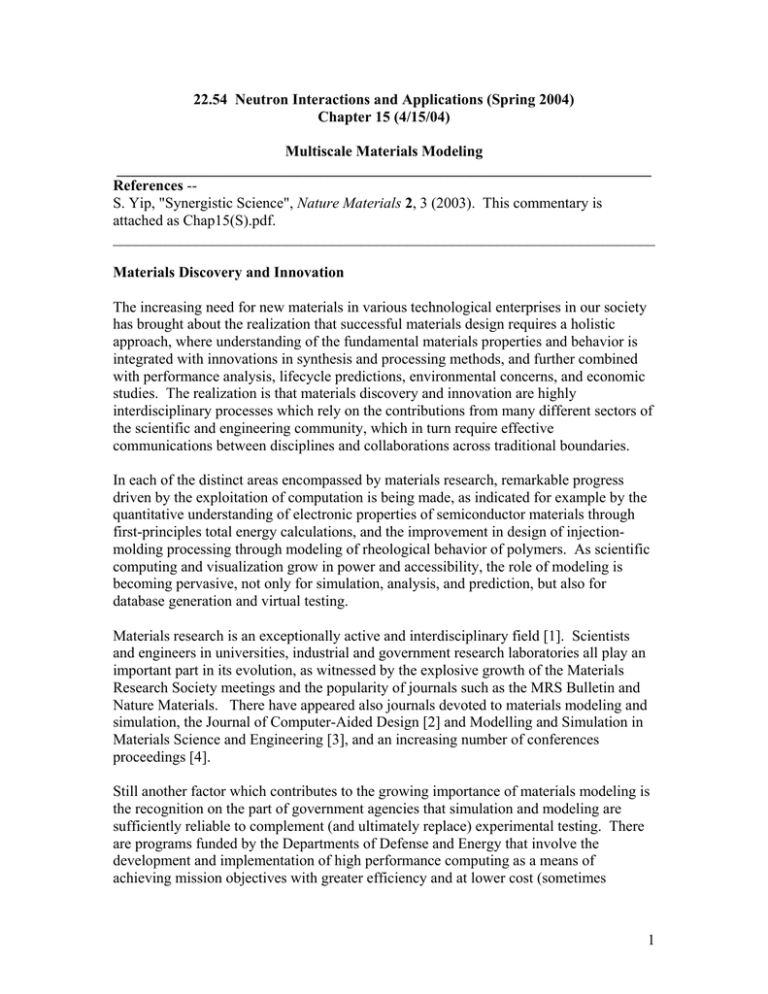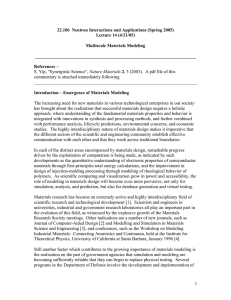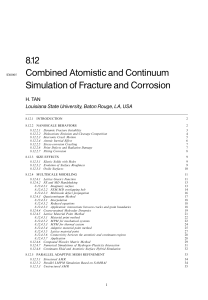22.54 Neutron Interactions and Applications (Spring 2004) Chapter 15 (4/15/04)
advertisement

22.54 Neutron Interactions and Applications (Spring 2004) Chapter 15 (4/15/04) Multiscale Materials Modeling _______________________________________________________________________ References -S. Yip, "Synergistic Science", Nature Materials 2, 3 (2003). This commentary is attached as Chap15(S).pdf. ________________________________________________________________________ Materials Discovery and Innovation The increasing need for new materials in various technological enterprises in our society has brought about the realization that successful materials design requires a holistic approach, where understanding of the fundamental materials properties and behavior is integrated with innovations in synthesis and processing methods, and further combined with performance analysis, lifecycle predictions, environmental concerns, and economic studies. The realization is that materials discovery and innovation are highly interdisciplinary processes which rely on the contributions from many different sectors of the scientific and engineering community, which in turn require effective communications between disciplines and collaborations across traditional boundaries. In each of the distinct areas encompassed by materials research, remarkable progress driven by the exploitation of computation is being made, as indicated for example by the quantitative understanding of electronic properties of semiconductor materials through first-principles total energy calculations, and the improvement in design of injectionmolding processing through modeling of rheological behavior of polymers. As scientific computing and visualization grow in power and accessibility, the role of modeling is becoming pervasive, not only for simulation, analysis, and prediction, but also for database generation and virtual testing. Materials research is an exceptionally active and interdisciplinary field [1]. Scientists and engineers in universities, industrial and government research laboratories all play an important part in its evolution, as witnessed by the explosive growth of the Materials Research Society meetings and the popularity of journals such as the MRS Bulletin and Nature Materials. There have appeared also journals devoted to materials modeling and simulation, the Journal of Computer-Aided Design [2] and Modelling and Simulation in Materials Science and Engineering [3], and an increasing number of conferences proceedings [4]. Still another factor which contributes to the growing importance of materials modeling is the recognition on the part of government agencies that simulation and modeling are sufficiently reliable to complement (and ultimately replace) experimental testing. There are programs funded by the Departments of Defense and Energy that involve the development and implementation of high performance computing as a means of achieving mission objectives with greater efficiency and at lower cost (sometimes 1 personnel safety is also an issue). Examples of this trend are the High Performance Computing Modernization Program [5] and the Accelerated Strategic Computing Initiative which is closely coupled to the Science-Based Stockpile Stewardship, itself a national program of unprecedented scope and commitment [6]. As the capabilities of materials modeling expand in both breadth and depth, molecular engineering of materials becomes more of a reality. This is the long-held dream of every materials scientist and engineer where new materials can be created with such benefits as enhanced performance, extended service life, and acceptable environmental impact, not to mention cost reduction. Although computer-aided materials design is still lagging behind computer-aided molecular (drug) design, significant progress is being made, especially in the area of functional materials for microelectronics, optical and magnetic applications [7]. In contrast, for structural materials the complexities of mechanical, thermal, chemical (alloying, corrosion, etc.) phenomena continue to pose formidable challenges to reliable and predictive modeling. As a result, it is becoming recognized that the most promising approach to the understanding and control of these phenomena is to effectively combine several modeling techniques, each one being suited for a particular length and time scale. This concept is now known as multiscale materials modeling. Length/Time Scales in Materials Modeling It is true in many fields of scientific inquiry that a single physical phenomenon can be examined at several levels or length (time) scales. For example, the complicated motion of a ocean wave as it washes onto a beach can be observed by watching a movie, or it can be visualized in terms of the individual movements of the water molecules which make up the wave. Depending on the scale of interest, the relevant dynamics requires quite different ways of analysis - in this case, continuum fluid dynamics to describe waves breaking on a beach and discrete-particle molecular dynamics to describe the atomic motions of the molecules. For problems concerning the properties and behavior of materials one can identify four distinct length scales where different aspects of the same phenomenon can be analyzed. As shown in the figure below these four regions may be referred to as electronic The Four Length Scales in Multiscale Materials Modeling Continuum (CFD/CE) Microstructure (FEM) Atomistic (MD/MC) Electronic Structure (ab initio) 1 understanding and prediction length [ A] 2 10 4 10 7 10 applications 2 structure, atomistic, microstructure, and continuum. Imagine a piece of material, say a crystalline solid. The smallest length scale typically of interest for materials science is about a few angstroms (10-8 cm) because on this scale one can deal with the individual electrons of an atom. Notice that we do not go to even smaller scales such as a Fermi (10-13 cm) which would be relevant for nuclear phenomena. The appropriate method for describing electrons is based on the Schrödinger wave equation since electrons are quantum mechanical particles. Calculations using this method are called first-principles, electronic-structure or ab initio, because one does not require any experimental input (this is not to say that there are no approximations) [8]. A widely used current approach makes use of a fundamental connection between the energy of the system of ions and electrons and the electron density, hence it is called density functional theory. Being quantum mechanical, electronic-structure calculations are more computationally demanding than calculations at the other three scales. As a result it can be applied only to small systems, no more than 300 atoms. The next scale, spanning hundreds of angstroms, is called atomistic. Here discrete particle simulation techniques of Monte Carlo and molecular dynamics are well developed (see the discussions in Chaps 8 and 14). These methods require the specification of an interatomic potential function which are usually developed empirically, by fitting a functional form with several parameters to experimental data. The usefulness of atomistic simulation is that one can study a system of N atoms, where at present N can be as large as 109. On the other hand, by ignoring the electrons atomistic simulations are not as reliable as ab initio calculations. At the level above atomistic, the relevant length scale is a micron (104 angstrom). Here the simulation technique commonly in use is finite-element calculations. Because many useful properties of materials are governed by the microstructure, this is perhaps the most critical level for materials design. Notice, however, that the information required to carry out such calculations (for example, the stiffness matrix, or any material-specific physical parameters in the calculation) has to be provided either from experiment, if available, or from studies at the atomistic or ab initio level. To a large extend, the same can be said for the continuum level, namely, the parameters needed to perform the calculations have to be supplied externally. We now see why the different techniques of simulation need to be linked. For practical design calculations, either continuum or finite-element methods are most appropriate. Since they require parameter or property specifications which cannot be generated within these methods, and nor can they provide the atomic-level insights which are essential for design, atomistic and ab initio methods are needed. It is only when the different methods are effectively integrated that one can expect materials modeling to give fundamental insight as well as reliable predictions on the appropriate length scale. Once this is achieved, then materials modeling can claim to be a valuable complement to experiment and theory. In as much as the advantages of linking simulation and modeling techniques across different length scales are readily apparent, the actual implementation is highly 3 nontrivial. It is fair to say that no single research group has successfully demonstrated such a capability. At recent workshops where this issue was raised and discussed, the conclusion was that one should focus on specific problems and work on a case by case basis in order to gain some much-needed experience. Given that this is a recognized critical issue facing the materials modeling community, one can expect progress will be made in a sustained manner [9]. The remainder of this lecture is a powerpoint presentation of current research problems and findings in the Yip research group with focus on studies of strength, deformation and toughness of metals and ceramics with a view toward understanding functional nanostructures. Bibliography [1] Materials Science and Engineering for the 1990s - Maintaining Competitiveness in the Age of Materials (National Academy Press, Washington D.C., 1989). [2] Journal of Computer-Aided Materials Design, A, K. Cheetham, U. W. Suter, E. Wimmer, S. Yip, editors, published by ESCOM Science Publishers, Leiden, The Netherlands. [3] Modelling and Simulation in Materials Science and Engineering, M. I. Baskes, editor, published by Institute of Physics Publishing, Bristol, United Kingdom). [4] For an example see volume 3 of Journal of Computer-Aided Materials Design under the title of Modeling Industrial Materials (August 1996). [5] Physics Today, September 1996, pp. 77-78. [6] Scientific American, March 1997, pp. 14-16. [7] E. Wimmer, "Computational Materials Design: A Perspective for Atomistic Approaches", Journal of Computer-Aided Materials Design 1, 215 (1993). [8] Richard M. Martin, Electronic Structure (Cambridge Univ. Press, 2004). [9] See the commentary in Nature Materials by S. Yip cited above for a recent update on multiscale marterials modeling, see also the website http://mmm.mit.edu for the Yip research group at MIT. 4




